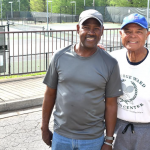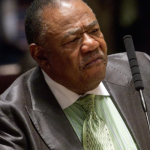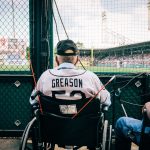By Solomon Crenshaw Jr.
For The Birmingham Times
The seeds for the continued growth of tennis in Birmingham could take root on soon-to-be resurfaced courts, thanks in part to grants from the United States Tennis Association (USTA).
The work is being done in conjunction with the City of Birmingham and the Birmingham Park and Recreation Board.
The funds will be used to resurface all 10 courts at James Lewis Tennis Center at Ensley Park and four courts at George Ward in southern Birmingham.
The James Lewis Education and Tennis Foundation (JLETF), which operates the George Ward and the James Lewis Tennis Centers, is recipient of two Tennis Venue Services grants from the USTA totaling $25,000.
“It’s our mission is to promote and develop the game of tennis,” said Todd Carlson, the USTA’s director of Tennis Venue Services, Parks & Community Tennis Associations. “It’s hard to do that without a court to play on.”
Beyond being resurfaced, the James Lewis courts in Ensley will get improved fencing and windscreens, said JLETF Vice President Donald Smith.
“It would be nice to have our kids see what a first-rate facility looks like with clean courts, windscreens, no cracks, no weeds,” Smith said. “It will be giving them something to look forward to and plant a seed. We’re hoping they will continue to grow tennis and maybe (junior players can) even get some scholarships.
“Our main goal is to get more minorities exposed to tennis, and giving our kids an opportunity to learn the game of tennis,” he said. “We really want to make a big difference and also have an educational component with that.”
Rudy Lewis, founder and former president of JLETF and director of George Ward Tennis Center, said four of George Ward’s eight courts will be resurfaced. The lower courts, which were last resurfaced in 2018, will be pressure washed, he said.
Lewis, who is not related to the man for whom the foundation is named, said the women’s tennis program at UAB formerly played its home matches at George Ward but stopped playing there because the courts are substandard, he said.
“With the resurfacing project, we will be able to get UAB ladies tennis back here,” he said. “I think they’ll be elated to be back here because it’s right close to the UAB campus.
“There’s nothing like having a facility that looks first class,” Lewis continued. “When you’ve got a facility that meets standards, more people are going to come out and become students, not only at the junior level but also the adult level.”
In 2005, USTA began providing grant funding to people to help build facilities, reconstruct facilities and resurface courts for the facilities.
“Since 2020, about $375 million of tennis infrastructure is what we’ve supported,” Carlson said. “That’s been probably about 1,700 tennis courts that we’ve helped.”
Beyond the money from the USTA Tennis Venue Services Fund, the project benefitted from $52,900 from Birmingham Park and Recreation, $1,000 from USTA Alabama and $21,000 from USTA Southern’s Build It Forward Facility Grant.
Carlson said the USTA Tennis Venue Services Fund also provides guidance from an engineer to walk applicants through the project.
“We basically meet people where they’re at and help guide them and support them,” he said. “We just tried to lower the risk of issues that that might occur. Not saying that they won’t occur … it just kind of helps be able to help them with the resurfacing project.”
The USTA’s mission goes beyond growing tennis and extends to helping communities fight inactivity, Carlson said.
“We’re about trying to bring communities together, and the health and wellness of these communities,” he said. “We know when these courts are fixed up and renovated that it (will be) a community hub where people can come together and get off the couch and really be active and enjoy themselves.
“It doesn’t matter what socioeconomic status you have,” he continued. “It doesn’t matter your age or anything else. You can play tennis with anyone and enjoy that great activity.”
James Lewis Tennis Center and the foundation are named for the self-taught tennis instructor who earned awards for his tireless efforts in the sport. He died in 1995 at age 76.










